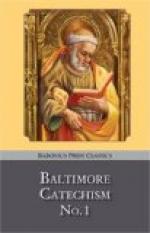When speaking of the Mass, I forgot to tell you something about the different kinds of Masses—that is, different as far as the ceremonies are concerned, for they are all alike in value. First we have the Low Mass, such as the priest says every day and at the early hours on Sundays. It is called low, because there is no display in ceremony about it. Next we have the High Mass—called Missa Cantata (sung)—at which the priest and choir sing in turn. Lastly, we have the Solemn High Mass, at which we have three ministers or priests, and singing by both ministers and choir, as well as all the ceremonies prescribed by the Church. When any of these Masses are said in black vestments they are called Requiem Masses, because the priest offers them for the rest or happy repose of the soul of some dead person or persons, and the word requiem means rest. Vespers is a portion of the Divine Office of the Church. It is sung generally on Sunday afternoon or evening in the church, and is usually followed by Benediction of the Blessed Sacrament. It is not a mortal sin to stay from Vespers on Sundays, even willfully, because there is no law of the Church obliging you to attend. Nevertheless all good Catholics will attend Vespers when possible.
To continue about the ministers of the Church: When the subdeacon is ordained a deacon, he can wear still more of the priestly vestments, and also baptize solemnly, preach, and give Holy Communion. After a time the deacon is ordained a priest, and receives power to celebrate Mass and forgive sins. If afterwards the priest should be selected by the Holy Father to be a bishop, he is consecrated; and then he has power to administer Confirmation and Holy Orders, ordaining priests and consecrating bishops. Thus you see there are grades through which the ministers of the Church must pass. First the tonsure, then Minor Orders, then subdeaconship, then deaconship, then priesthood. Nuns, Sisters, Brothers, etc., are not, as some might think, ministers of the Church, because they have never received any of the Holy Orders.
The ordained ministers of the Church can perform the duties of any office for which they have ever been ordained, but not the duties of any office above that to which they have been ordained. For example, a subdeacon cannot take the place of a deacon at Mass, nor a deacon the place of a priest; but a priest may take either of their places, because he has, at one time, been ordained to both these offices.
Altar boys should never forget that they are enjoying a very great privilege in being allowed to take the place of an ordained minister of the Church, and serve Mass without being ordained acolytes.
In olden times princes and noblemen used to seek for this wonderful favor, and count themselves happy if they secured it. Think of it! To stand so near our Blessed Lord that they are able to see His sacred body resting upon the altar, and to offer the wine, which a few minutes later is changed into His very blood!




